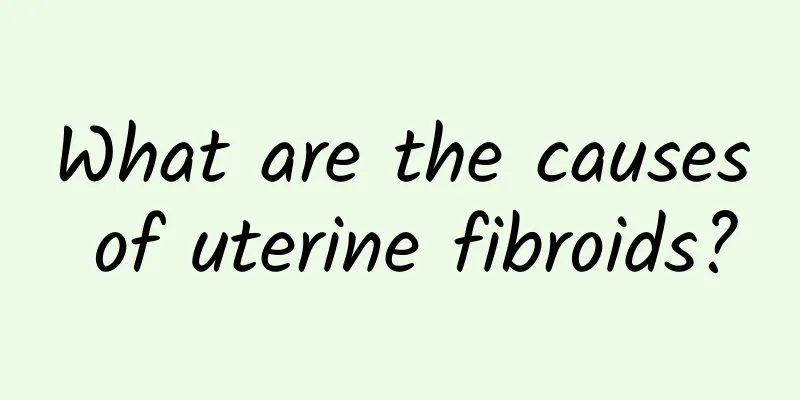Why do uterine fibroids sometimes appear and sometimes disappear?

|
Why do uterine fibroids sometimes appear and sometimes disappear? Explore the situation where uterine fibroids sometimes exist and sometimes disappear, and answer the question of why uterine fibroids sometimes do not exist. Paragraph 1: What are uterine fibroids? Definition and symptoms Uterine fibroids are a common female reproductive disease that occurs mostly in premenopausal women of childbearing age. It is a benign tumor that usually forms inside or outside the uterine wall. Symptoms of uterine fibroids include abnormal menstrual bleeding, menstrual cycle disorders, and lower abdominal pressure. Paragraph 2: Causes of uterine fibroids Vice: Hormonal imbalance and genetic factors The cause of uterine fibroids is still not completely clear, but it is generally believed to be related to hormonal imbalance and genetic factors. Hormonal imbalance can lead to excessive thickness of the endometrium, thus providing the basis for the formation of uterine fibroids. Studies have found that uterine fibroids are also closely related to genetic factors. Paragraph 3: Diversity of causes leads to differences in symptoms Classification of accessory uterine fibroids Uterine fibroids can be classified into a variety of types. According to their location, they can be divided into adenomyoma, myometrial fibroids, and uterine cavity fibroids. According to the morphology of the lesions, they can be divided into dot-shaped, plaque-shaped, nodular, and diffuse. Different types of uterine fibroids can cause different symptoms, sometimes with obvious symptoms and sometimes without obvious symptoms. Paragraph 4: The impact of pregnancy factors on uterine fibroids Vice: Hormonal changes and pregnancy Changes in hormone levels play an important role in the development of uterine fibroids. During pregnancy, the hormone levels in a woman's body change dramatically, among which the level of progesterone increases significantly, which may inhibit the growth of uterine fibroids. Therefore, sometimes, during pregnancy, uterine fibroids may "disappear" and no longer cause obvious symptoms. Paragraph 5: Endocrine disorders lead to fluctuations in the condition Adverse life stress and endocrine disorders Life stress has a certain impact on women's physiological condition. Long-term exposure to high-stress environment may lead to endocrine disorders, affect the production and secretion of hormones, and may lead to fluctuations in the condition of uterine fibroids. Sometimes, the condition may be aggravated when the stress increases; and once the stress decreases, the condition may also be alleviated. Sometimes uterine fibroids are absent, which is related to multiple factors such as hormone levels, pregnancy factors, life pressure, etc. At the same time, the type and shape of uterine fibroids may also lead to differences in the condition. In order to maintain a good quality of life, women should seek medical treatment in time when they find uterine fibroids, understand their own condition, and receive treatment or observation according to the doctor's advice. |
>>: When will uterine fibroids be removed? When will uterine fibroids be removed?
Recommend
What are the causes of irregular menstruation?
What are the causes of irregular menstruation? Ir...
What medicine should I take if I don't have my period?
What medicine should I take if I don’t have my pe...
Can I exercise if I have uterine fibroids?
Can you exercise if you have uterine fibroids? Ut...
How long will it take for dysfunctional uterine bleeding to heal? These 3 factors will affect the recovery time
There is no uniform answer to the recovery time o...
How long does it take to live with cervical erosion?
How long a person with cervical erosion can live ...
Taboos about abortion
Abortion is very common, and there are abortions ...
Some precautions after abortion in winter
Abortion is a common surgery, and many women do i...
How long does it take to get your period after an abortion?
Before an abortion, people always think about how...
What foods can I eat to eliminate uterine fibroids?
What foods can I eat to eliminate uterine fibroid...
Uterine hypoplasia can easily lead to dysmenorrhea
It is very common for women to have dysmenorrhea....
What should patients with uterine fibroids pay attention to in their diet?
What should patients with uterine fibroids pay at...
How does Traditional Chinese Medicine classify and treat dysmenorrhea?
TCM has a trick for treating dysmenorrhea by clas...
Have you ever heard of bacterial vaginosis?
Vaginitis is a common disease, and the number of ...
What are the dietary taboos for patients with cervicitis?
Everyone knows about cervicitis. In life, there a...
What is the chance of curing dysmenorrhea?
What is the cure rate of dysmenorrhea? The occurr...









